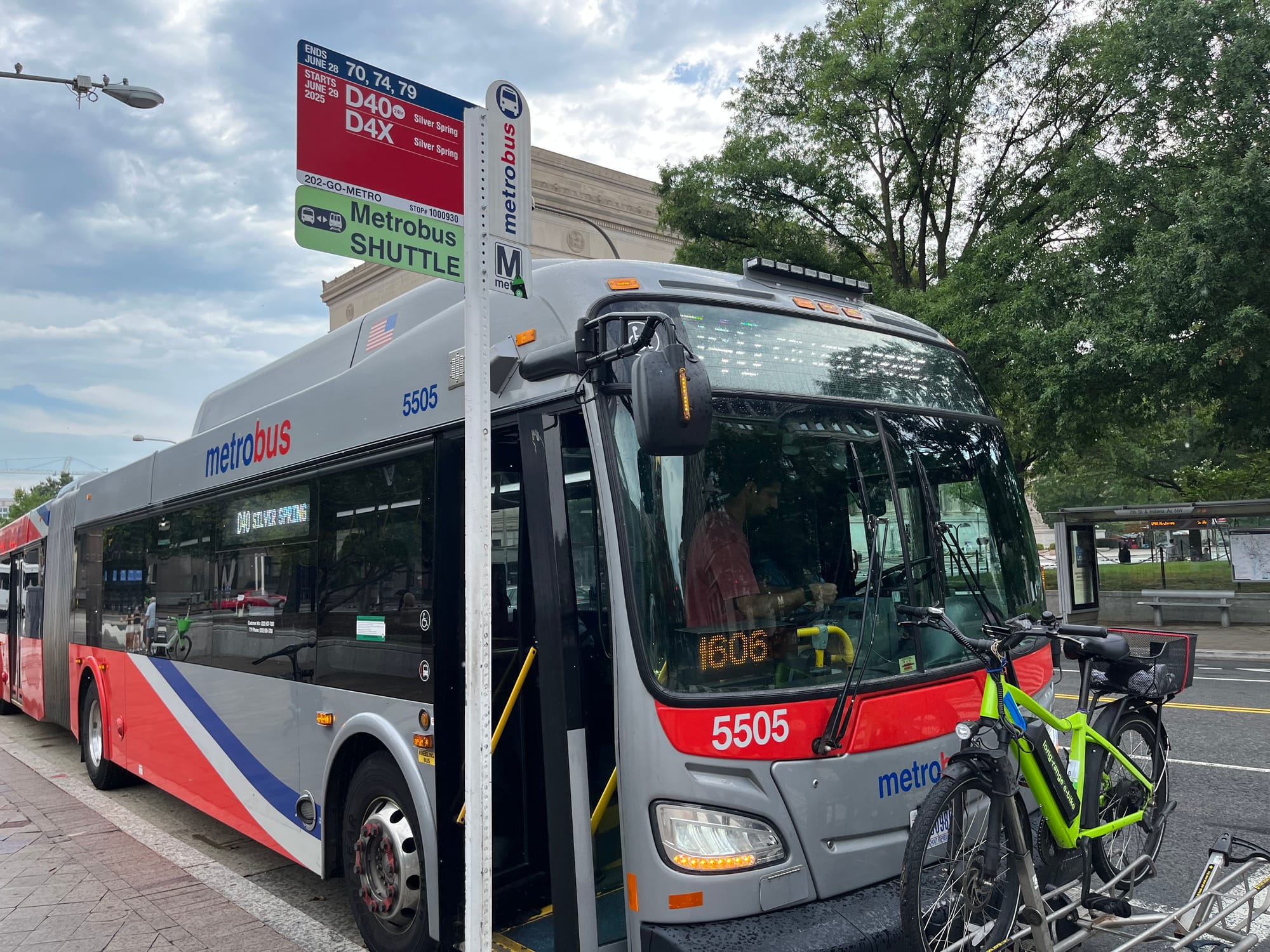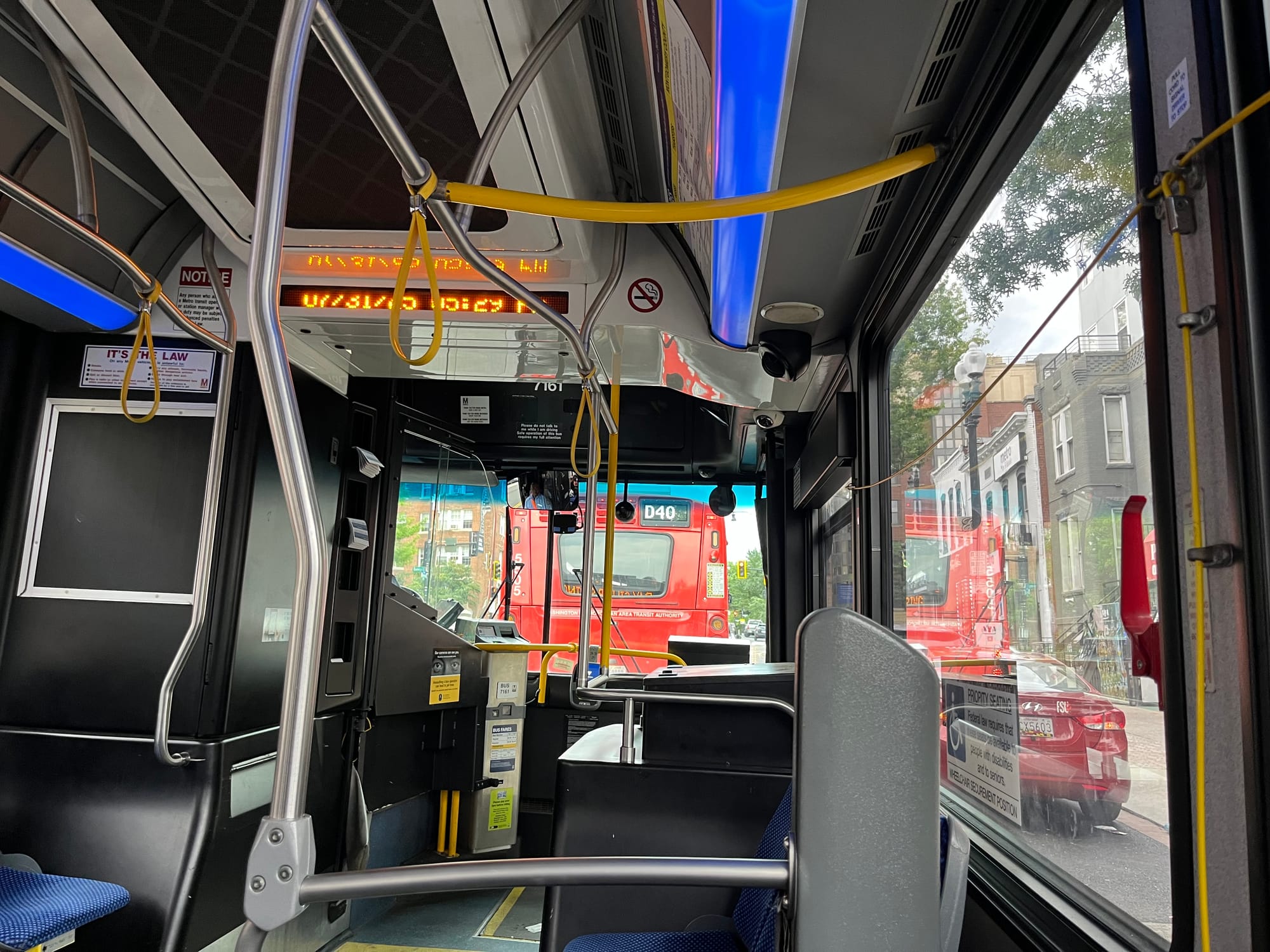A note from Martin
The 51st's first full-time reporter reflects on what it means to be a D.C. news outlet in 2025.
One month in, riders are still adjusting to the massive Metrobus overhaul.

“Well,” says one of the half dozen passengers waiting for the Metrobus, looking at the Transit app on his phone. “It says the bus should be here now.”
It isn’t. The D4X, which is traveling a northbound express route on one of the region’s busiest corridors, is nowhere in sight. But Kai Hall, Greater Greater Washington’s D.C. policy manager and Transportation Equity Network coordinator, doesn’t panic.
He refreshes the app. Now, it says seven minutes.
In D.C., waiting for the bus isn’t new. But figuring out where it’s going, or what it’s called, might be after WMATA overhauled the entire Metrobus network at the end of June. In an effort to make the bus system easier, faster, and more reliable, Metro renamed every bus, eliminated more than 500 stops, and re-routed several lines.
The 51st heard about how it’s going from more than 30 bus riders who shared their experiences with the new system. The verdict?
Well, it’s mixed. While some commuters say they’ve benefited from new connections and more frequent service, others say the overhaul has involved more confusion than clarity.
Hall’s bus arrives only a minute later, at 5:05 p.m., and he settles in for a ride that’s estimated to take 53 minutes via the express route. Google Maps estimates that it would take 45 minutes by car.
The D4X is traveling along the Georgia Ave corridor to Silver Spring, a route previously served by the busy 70 and 79 buses. But like every other bus route in the region, they were renamed last month to bring order to a patchwork system.
Mónica Martínez López, an Advisory Neighborhood Commissioner in Ward 5 and daily bus rider, says she doesn’t find the new names intuitive.
“I still don’t know the new names of my old routes,” she says. “It’s too many changes at once.”
And she isn’t alone; several riders made social media comments about the challenge of remembering the new lines. Others have waxed nostalgic about how the old names were integrated into the city’s cultural fabric.
“All of those letters and numbers I used to know are a dead language now,” wrote Dan Reed, Greater Greater Washington’s Maryland policy director, last month. “Better Bus means redrawing our mental maps so we can relearn how to reach the places we’re already going.”
Under the new naming system, the first letter corresponds with the area serviced: “D” routes generally run downtown, while “C” routes go crosstown in D.C. Other letters represent jurisdictions outside the city: "A" for Arlington/Alexandria, “F” for Fairfax City, Fairfax County, and Falls Church, and "P" for Prince George's County. The second number refers to the part of the city that the bus line is servicing, according to Metro. For this, the numbers begin with 1 in Southeast and move counterclockwise (this Reddit user made a helpful visualization). The third character is either an additional number or an “X”, which denotes express routes.

Metro acknowledged the learning curve in an emailed statement: “It will take some time to adjust to the new routes and names. The best way to adjust is to plan one trip at a time.”
Other changes, including the introduction of some new routes, have been met with praise.
Emma Zaballos, a Ward 1 resident and, admittedly, casual bus rider, has been pretty happy with the new service. When the new D74 was unveiled, connecting neighborhoods in Brookland and Columbia Heights to the business and commercial areas in Adams Morgan and Foggy Bottom, she couldn’t help but ask: “Why haven’t we had this before?”
Readers have also highlighted the C63, connecting Deanwood and Washington Hospital Center, as a new connection that makes sense. Still, others have mentioned how they mourn the loss of their old buses, like the 74 near the Wharf.
Ultimately, “it was impossible to do something as big as overhauling an entire region’s bus network without friction,” Zaballos says. “But I think they’re doing a pretty good job.”
Metro seems to agree. In a board of directors meeting last month, WMATA General Manager and CEO Randy Clarke said the network has gone “better than even expected” in many ways.
Other parts of WMATA’s redesign efforts, like stop consolidation, are visible along Georgia Ave NW as the D4X speeds past a relic of the old network: a decommissioned 70 bus stop sign still standing.
David Shaw, a tour guide and Ward 4 resident, says his biggest challenge has been figuring out where to catch the bus now.
“Metro has done a great job of telling you where a stop is not going to be,” he says. “But they haven’t told you where it is going to be in the future.”
After a nearby bus stop was removed, Shaw said he struggled to find an accurate stop location, and he found the Metro app unhelpful.
Metro generally recommends using its Trip Planner and MetroPulse app to navigate the new system. But several riders say they’ve encountered glitches and outdated information. Hall recommends the third-party Transit app and some patience.
Metro says feedback from riders has already helped shape early adjustments to the Trip Planner and other aspects of the rollout.
According to the agency, about 150 signs (known as bus flags) needed correction, which Metro points out amounted to 1.75% of the region’s 8,500 total bus stops.
Other hiccups included routes that needed tweaking due to heavy traffic flows or narrow streets. On the C37, for example, 41st Street SE proved too narrow to operate buses in both directions. They had to re-route the bus to stay on Southern Avenue between Pennsylvania Avenue SE and Bowen Road SE.
“These minor issues are expected with a network redesign of this size and scale and are addressed as they come to our attention,” the agency said in a statement.
One of riders’ most persistent frustrations has been so-called ghost buses, when an app says a bus is supposed to come but never shows up. Metro says the redesign hasn’t necessarily worsened the issue.
“There are a variety of reasons why a trip may be missed, and most of them are not related to the new network,” they wrote. “The main reason for these missed trips, which also happened before the new network, is a shortage of bus operators on that particular day.” (They say hiring is underway; other culprits include storms, traffic accidents, and, of course, congestion.)

So what do the bus drivers themselves think of the overhaul?
Benjamin Lynn, a spokesman for the Amalgamated Transit Union (ATU) Local 689, which represents approximately 2,500 bus operators for WMATA, says many drivers were able to find similar routes to the ones they had before. He mentions that common complaints about the new routes predate the Better Bus network, including the timing between bus stops and operators feeling like they don’t have enough time to drive from point A to point B.
Lynn also wants to remind everyone that the bus operators are in the same boat as the public — they didn’t “necessarily get a vote in the decision-making process” about the new network.
As they adjust to the changes, “we appreciate the public being patient with the operators,” he says. “And the operators are also understanding that the customers may have some confusion with the new bus routes as well. We’re all in this together. We’re all pulling in the same direction.”
About halfway through Hall’s ride, the D4X pulls up behind two northbound D40 buses. It caught up to the local-service routes that left earlier. Now all three are stuck in the same lane.
But that, as Hall points out, isn’t necessarily on WMATA. Georgia Avenue is one of the busiest corridors in the city (according to DDOT, half of the people traveling on it are riding a bus), and advocates feel the street-wide infrastructure controlled by the city hasn’t kept up.
“If you ride the bus, it’s safe to assume you want it to show up on time and be competitive with driving,” Hall says. “There are ways to do that, and it’s structural.”
Advocates have pushed for a bus priority project on Georgia Ave, similar to one implemented in Adams Morgan and another planned for H Street NE. The hope is that dedicated bus lanes, curb extensions for bus stops (known as bulb-outs), and other changes would improve bus speed, tackling what local advocates have dubbed the city’s “transportation time tax” (how much longer it takes to travel the same route by transit than by car).
According to research done by Greater Greater Washington earlier this year, Ward 8 has the highest average transportation time tax in the District.
WMATA said the new bus network would expand access for these and other riders in so-called equity-focused communities, estimating that 14,000 residents in EFCs gained access to high-frequency bus services during the weekday morning rush and an additional 58,000 gained access in the evenings.
Patrice Lancaster, a community activist in Bellevue who wrote an open letter to her ANC commissioner earlier this spring about her concerns with the Better Bus implementation process in Ward 8, said she’s been pleasantly surprised by the more frequent and extended bus service.
“Right now, it’s doing extremely well,” she said. Her youngest son, who was never familiar with public transit, has found it easy to use the new routes to commute to his summer job.
“He feels safe,” she said, noting that her open letter saved the bus stop near their home from elimination. “But I am concerned for when school starts because that’s when traffic and the need for security increases.”
Hall believes it may be too early to make a final call on how it’s going, but he does know one thing: Cost-neutral transitions, or changes that don’t require additional costs, like this one, are challenging.
“There are winners and losers in all of this,” he says. “And to me, it’s not clear who is winning the most or who is losing the most. It’s still too early.”
At the same time, Metro says that the “Better Bus efforts don’t end with the new network.” Riders are welcome to continue providing comments via their customer engagement form; the agency says someone reads every comment.
As summer draws to a close, Metro says it has plans to help onboard parents and students onto the new system. And staff also expect to provide updated data and metrics at their September board of directors meeting.
Back on the bus with Hall, the D4X pulls into its final Silver Spring station stop at 5:55 p.m. Turns out, the ride was only 50 minutes after all.
With your help, we pursue stories that hold leaders to account, demystify opaque city and civic processes, and celebrate the idiosyncrasies that make us proud to call D.C. home. Put simply, our mission is to make it easier — and more fun — to live in the District. Our members help keep local news free and independent for all: